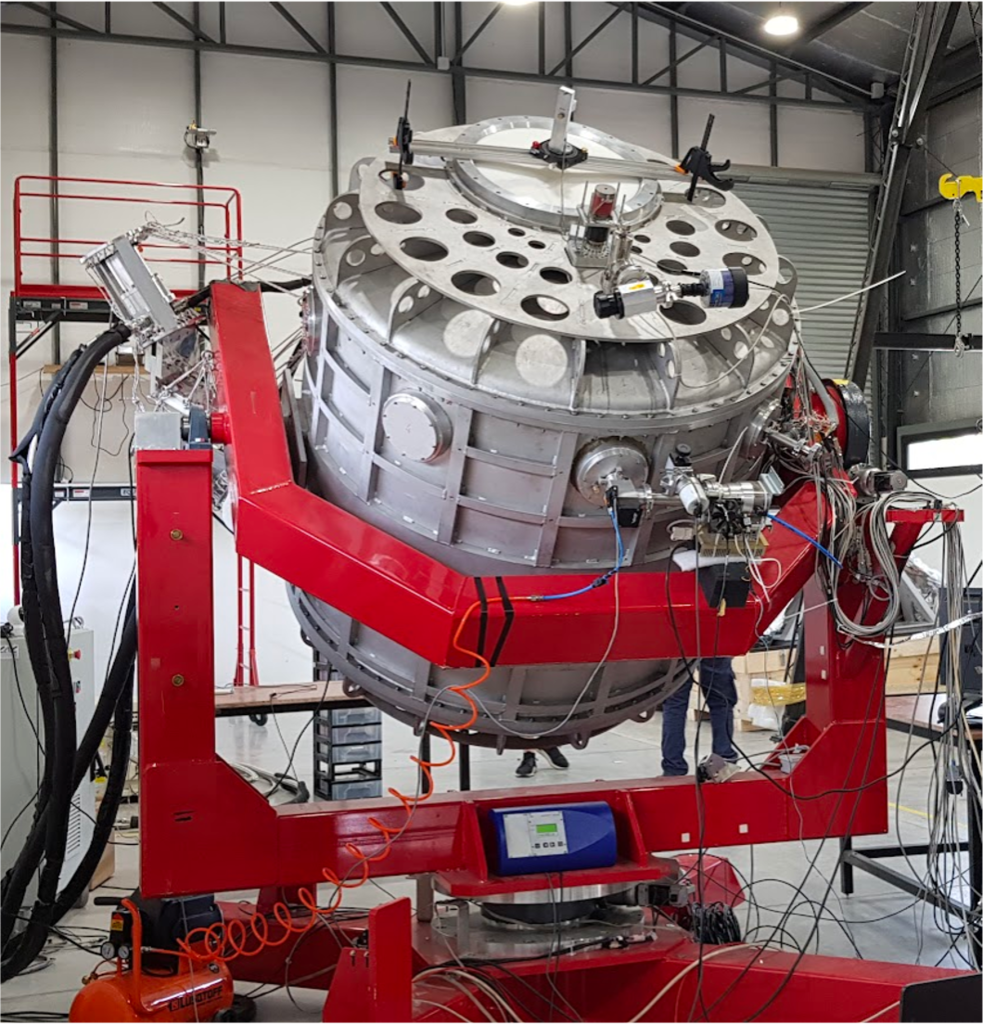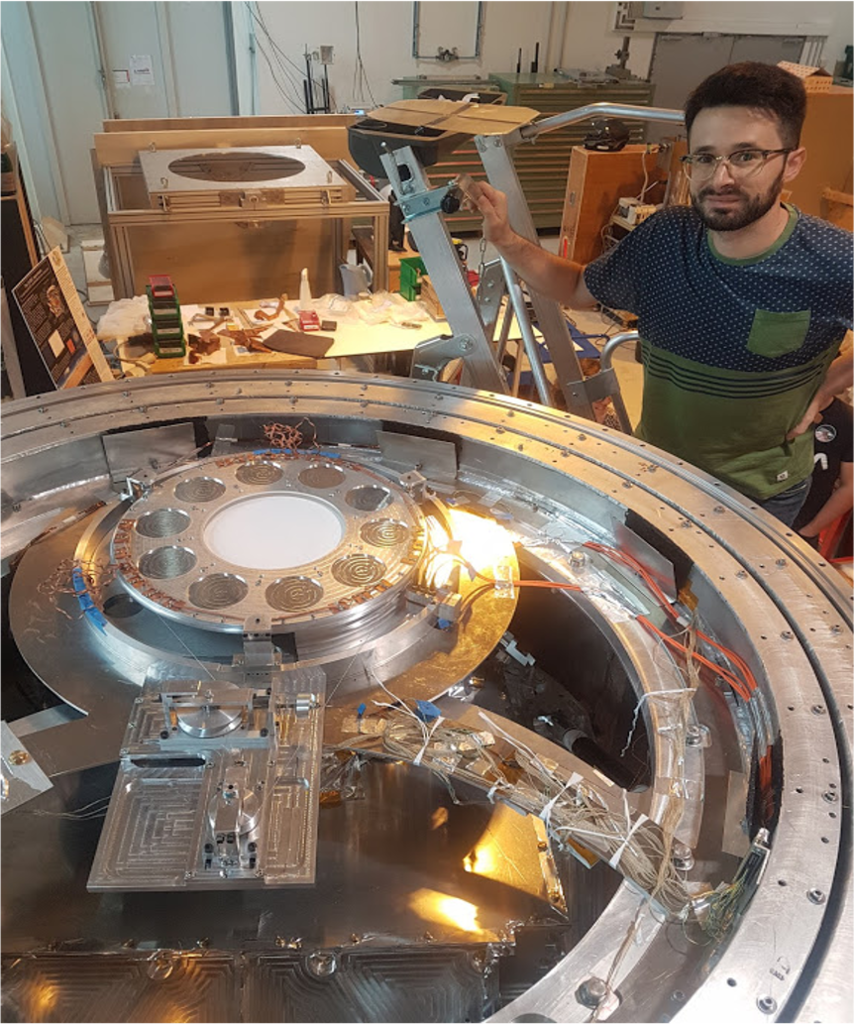
QUBIC, a new way to study the primordial universe
Today, Thursday, April 21, a special issue of the Journal of Cosmology and Astroparticle Physics, features eight articles by QUBIC (Q&U Bolometric Interferometer for Cosmology). This international collaboration is currently making a telescope in Argentina to study the newborn universe using an innovative technique. QUBIC will observe and map the properties of the cosmic microwave background, the residual echo of the Big Bang. It will specifically measure particular components of the cosmic background radiation's orientation of the microwave oscillation in the plane of the sky (polarisation), called B-modes, which are indicative of possible perturbations induced by gravitational waves generated in the first moments of the universe's life. Italy will play a leading role in the project thanks to the scientific and technological contributions of the INFN (National Institute of Nuclear Physics) and the Universities of Milan "Statale", Milan-Bicocca, the University of Rome "Tor Vergata" and Sapienza University of Rome. QUBIC will observe the sky from the end of 2022, from a high-altitude desert site (5000 m) in Argentina, near San Antonio de Los Cobres.
Following its development and integration in the European laboratories belonging to the universities and research institutes involved in the collaboration, QUBIC arrived in Argentina, in the city of Salta, in July 2021, where it is undergoing the final calibration stages and laboratory testing. The results of these activities, presented in the eight papers published in the Journal of Cosmology and Astroparticle Physics, have confirmed the correct functioning of the instrument and bolometric interferometry, i.e. the newly developed technique on which QUBIC's observations will be based, which combines the very high sensitivity of detectors cooled to almost absolute zero (-273 °C) and capable of measuring the energy of the cosmic background radiation by transforming it into heat (bolometers), with the precision of interferometric instruments.
"QUBIC is an original and extremely complex instrument, which is why it was necessary to publish in advance all the details of its hardware and the new methods of exploiting the data collected. Furthermore, with these long and exhaustive calibrations, we have demonstrated the efficiency of QUBIC as a bolometric interferometer in the laboratory. It is an essential step for subsequent measurements of interest to cosmology and fundamental physics," says Silvia Masi, professor at Sapienza University of Rome and INFN researcher, who is coordinating the Italian participation in the experiment.
Thanks to its extreme sensitivity, which will enable it to distinguish the details of each of the 'pixels' into which the celestial map will be divided, QUBIC will be able to discriminate B-modes from signals generated by other sources in the sky, providing a direct test of the inflation theory. This is now the reference theory for describing what would have happened in the universe's first moments, developed in the 1980s to explain some features of the universe, including the 'flatness' and extreme homogeneity of space-time.
According to the inflation theory, the very rapid expansion phase of the universe immediately after the Big Bang, which lasted less than a hundred thousandth of a billionth of a billionth of a billionth of a second (about 10-32 seconds), would have left a weak background of gravitational waves, which in turn would have produced particular faint traces, called B-modes, in the polarisation of the cosmic microwave background. In practice, the cosmic background's electromagnetic waves would not oscillate in random directions. Instead, directions that form a swirling pattern in the sky would be slightly preferred.
The clarity and absence of humidity in the air at the Alto Chorrillo site, where the telescope will be installed, at around 5,000 metres above sea level on the La Puna plateau in northern Argentina, near the town of San Antonio de los Cobres in the Salta province, will also contribute to the accuracy of the measurements to be taken by QUBIC.
QUBIC will be brought to the Alto Chorrillo site within a few months. The first measurements will demonstrate the efficiency of the new bolometric interferometry method by observing astronomical sources for the first time. The instrument will then be completed by fitting more detectors to make measurements of cosmological interest within three years.
The search for B-modes represents a formidable and central challenge for physicists and astrophysicists. The signal to be measured is so weak that it requires ultra-sensitive detectors and high-precision telescopes, not least to remove, during data analysis, other locally biased signals that might confuse the measurement. QUBIC's measurements will therefore be simultaneous with those of half a dozen other experiments worldwide with the same scientific objective. Unlike the latter, which produce images directly through single-aperture telescopes, QUBIC will be the only instrument to make observations by collecting microwaves from many apertures and having them interfered with.
The measurement of such a weak signal will only be considered free of systematic errors if there are consistent results from very different instruments. This is why QUBIC, the only bolometric interferometer, is an irreplaceable resource in the search for B-modes and the study of the universe's first moments. Thanks to its multispectral and self-calibration capabilities, QUBIC will produce completely original and complementary data to those of other experiments, offering analysts countless possibilities for cross-checking and thus unparalleled robustness of results.
QUBIC is the result of the collaboration of 130 researchers, engineers and technicians in France, Italy, Argentina, Ireland and the UK. The instrument was integrated at APC laboratories in Paris in 2018 and calibrated during 2019-2021.
The Italian contribution has been fundamental to the development of the instrument and will continue to be so in the subsequent phases of the experiment. The instrument is housed in a cryostat, designed and built in the laboratories of the Sapienza University of Rome and the Rome section of the INFN, which can cool the detectors and the entire optical system of the interferometer to near absolute zero. The same group also developed the cryo-mechanical system that allows the optical components inside the cryostat to be rotated to measure the polarisation state of the radiation. Other cryogenic parts, which work at a temperature below -270 °C, are also Italian, such as the highly advanced corrugated antennas that select the photons to be interfered with, made in the laboratories of Sapienza and the INFN Section of Milano Statale. In contrast, the optics that focus the photons on the detectors and the system of shutters that allows the interferometer configuration to be varied and self-calibrated are made by Sapienza and Milano-Bicocca. The University of Rome 'Tor Vergata' and the INFN Section of Rome2 contribute to developing the complex data analysis software.
References:
QUBIC - Q & U Bolometric Interferometer for Cosmology:instrument, current status, and forecast - Journal of Cosmology and Astroparticle Physics https://iopscience.iop.org/journal/1475-7516/page/QUBIC_status_and_forecast
Further Information
Silvia Masi
Department of Physics
silvia.masi@roma1.infn.it



